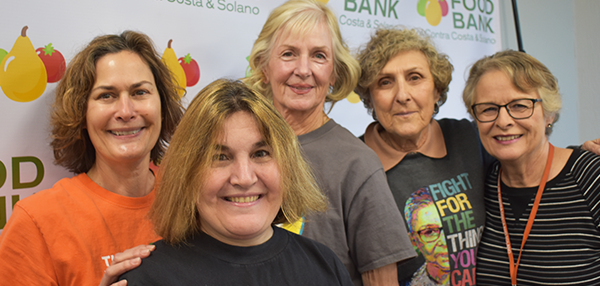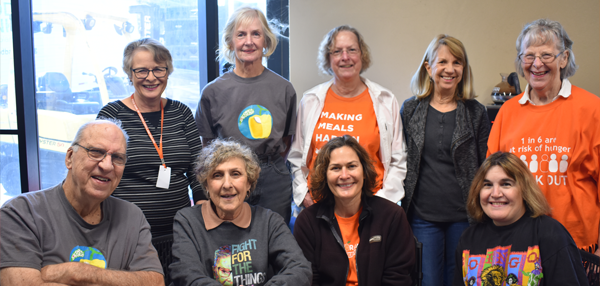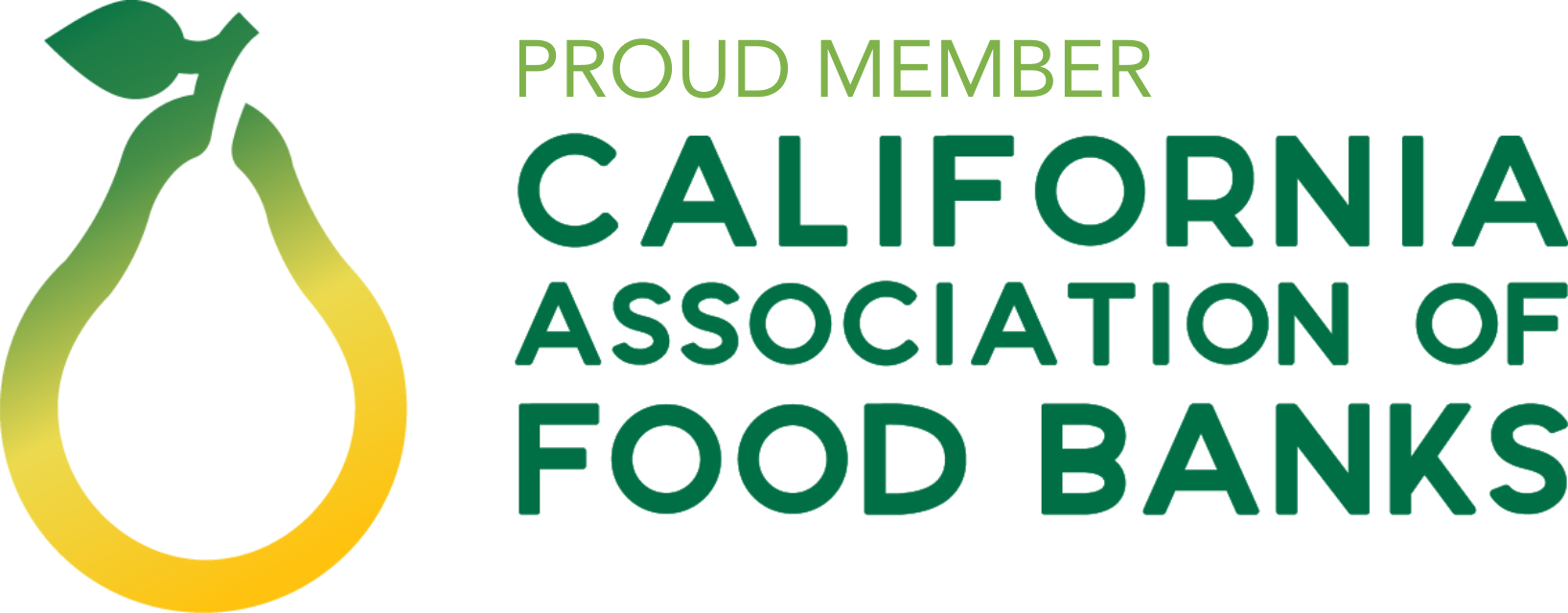Every day volunteers help us fulfill our mission to lead the fight to end hunger, in partnership with our community and in service to our neighbors in need. Food Bank volunteers make up the equivalent of fifty-seven full-time staff members, donating on average more than 117,000 hours annually. That’s a lot!
Through the years, some of our volunteers have decided to make a weekly or monthly commitment. One such group is our Farm 2 Kids group who come in to sort food on a weekly basis.
We asked five founding members to speak with us about their experience.

How did this group come together? When did this begin?
Group: 2009. It was the beginning of the Farm 2 Kids program.
(Farm 2 Kids is a Food Bank program that provides children attending after-school programs within low-income schools three to five pounds of fruits and veggies weekly to share with their families. To learn more, click here.)
Did someone reach out to you? Were you already volunteers?
Susan: I had been donating money to the Food Bank, but then I got laid off from my job. And I thought, okay, well I can’t really donate money any more, but now I have time. When I called they were starting a new program called “Farm 2 Kids.”
Lee: Wherever I lived, I was always involved in food services between a church and our temple. After I moved to Rossmoor in ’08, I started volunteering in July ’09, and it was just natural to come work in a food bank.
Jennifer: My husband’s employer supported the Food Bank and he got a newsletter which said there was going to be an open house. When I was in college I helped at a food bank, and I really enjoyed it, but I hadn’t done it in years. I wanted to get involved in something like that so I said, “Let’s go to the open house at the Food Bank.” It was there that I learned about “Farm 2 Kids.”
Donna: I had just retired, but I had volunteered at the Food Bank off and on with my company and also with an insurance women’s group which came once or twice a year. So I knew of the Food Bank and I liked the atmosphere. It just happened to be that when I called, this program was just starting.
Carol: I live in San Ramon and I walked to a Safeway to do my grocery shopping. It was the fall. There were two large Food Bank trucks in the parking lot and people standing next to the barrels at the entrance to the store with a list of what foods would be good to donate. Safeway had prepackaged bags for purchase. I purchased a bag and when I came back out a woman stopped me in the parking lot to say “Thank you very much.” And I said, “Tell me about this. I’ve never seen this process before.” And she asked me if I would like to see it. I said “Sure.” So that’s how I got involved. I donated at the Safeway and the person I met was Sharon Zeppegno, the Food Bank’s Volunteer Manager.
Carol, I heard that before you retired, you came on your lunch break. How come?
Carol: Because there were wonderful people in this group. We bonded right away. I worked in Walnut Creek at Kaiser Permanente and they were very big on having their employees donate time to the community.
So, what drives you to keep coming back?
Jennifer: Because there’s a need and because I enjoy it—and the need doesn’t just go away over time. We have to give back to our community. I’ve gotten to know these people and I am incredibly fond of them. It’s become a close-knit group.
Susan: Once we started doing this, we got to know everybody. When someone is not there you think, “What happened?” You find yourself asking each other, “Are you going to be here next week?”
Lee: We email each other if we aren’t going to be here. We also turned our group into a book club. We’ve been exchanging books for 10 years.
Carol: I have real time, now that I am retired. So, I just kept on keeping on.
Lee: It’s like a family.
Jennifer: It is, and what’s nice about it is that we can sort our produce, but chat at the same time, catching up and talking about books and movies. There’s a lot of camaraderie.
Lee: And we’ve also seen each other through a lot of sadness. Ups and downs. Sadness and happiness.
Carol: We do know each other on a certain level. I look forward to coming every Monday to find out what people did last week or how their vacations were or what books they are reading. We have a special team. We have been together for years and to see the same faces every Monday is great.
Did you know each other before?
Group: No.
When people ask you about this group what do you say? Do your kids, your relatives, your neighbors know that you are doing this?
Group: Yes.
Lee: Monday is Lee’s day at the Food Bank.
Donna: I bring my grandchildren when they are out of school.
Lee: We’ve watched them grow up for ten years.
Susan: They’re good workers.
How old are they now?
Donna: They are 16 and 15. And the 15-year old is now working on an after school project related to the Food Bank. Volunteering with me here has developed her enjoyment in doing community service.
Whether you are retired or laid off or working, it’s a busy world. How do you make time to make a weekly commitment?
Group: Because Monday is Food Bank day. That’s our day.
Lee: It’s a commitment, so we show up.
Carol: What we do is important. We know we are right in the middle of an entire process. First people donate their fruits and vegetables to the Food Bank. Then we sort this food and finally, it goes out to the children in need. We can see where the food comes from, where it goes, and who benefits from it. That’s one big part of it for me. And then, to volunteer with like-minded people who are dedicated and caring creates camaraderie.
Susan: Not only does the Food Bank benefit from what we do, but we benefit too. We can feel good about what we’re doing—and come to catch up with our friends. It also doesn’t take a lot of training.
So, anybody could get involved?
Group: Yes.
Lee: It’s a lot of physical work, but as long as I am able, I’ll be here.
Jennifer: It’s a great workout. Especially if you are lifting the boxes.
Susan: And there are different jobs, so everybody can pitch in and do what they feel comfortable doing or what they are good at.
Do you have any stories from the last ten years?
Susan: Yes. The cherries. I love cherries and was excited for cherry season. Normally, the produce we sort is set up in a couple of bins, but in this case, there was one bin, and it was filled with cherries that we had to sort through. Everybody was gathered around one bin sorting cherries. We didn’t even get through half of it because they are little and you have to look at each one to make sure they are good. We never had to sort cherries again. [laughter]
Do any of you have a personal connection to hunger?
Group: No. We’ve been very lucky.
Jennifer: The Food Bank, Meals on Wheels, and SNAP provided assistance that prevented someone close to me from going hungry. And this person never did go hungry because of these services.
Do you volunteer at other places?
Susan: Planned parenthood.
Lee: Voter registration. I’ve been doing voter registration for 50 years at least.
Jennifer: Contra Costa Historical Society.
Carol: When I was still working, I donated my vacation time to Habitat for Humanity, and I still volunteer with them now. I am going to Ethiopia this year and the Philippines next year.

Interested in forming a group and making a commitment to volunteer at the Food Bank on a regular basis in 2020? We have many opportunities and we’d love to talk to you.
New volunteer opportunities: As of the time of this posting, we have several openings in Solano County for our new Mobile Food Pharmacy program (provided in partnership with Solano County and the Yocha Dehe Wintun Nation). Visit foodbankccs.org/mobilefoodpharmacyvolunteer.
Feel free to reach out to Volunteer Services at volunteerhelpdesk@foodbankccs.org.



